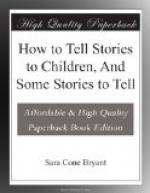It soon becomes easy to pick out from a collection such stories as can be well told; but at no time is it easy to find a sufficient number of such stories. Stories simple, direct, and sufficiently full of incident for telling, yet having the beautiful or valuable motive we desire for children, do not lie hidden in every book. And even many of the stories which are most charming to read do not answer the double demand, for the appeal to the eye differs in many important respects from that to the ear. Unless one is able to change the form of a story to suit the needs of oral delivery, one is likely to suffer from poverty of material. Perhaps the commonest need of change is in the case of a story too long to tell, yet embodying some one beautiful incident or lesson; or one including a series of such incidents. The story of The Nuernberg Stove, by Ouida,[1] is a good example of the latter kind; Ruskin’s King of the Golden River will serve as an illustration of the former.
[Footnote 1: See Bimbi, by Ouida. (Chatto. 2s.)]
The problem in one case is chiefly one of elimination; in the other it is also in a large degree one of rearrangement. In both cases I have purposely chosen extreme instances, as furnishing plainer illustration. The usual story needs less adaptation than these, but the same kind, in its own degree. Condensation and rearrangement are the commonest forms of change required.
Pure condensation is probably the easier for most persons. With The Nuernberg Stove in mind for reference, let us see what the process includes. This story can be readily found by anyone who is interested in the following example of adaptation, for nearly every library includes in its catalogue the juvenile works of Mlle. de la Ramee (Ouida). The suggestions given assume that the story is before my readers.
The story as it stands is two thousand four hundred words long, obviously too long to tell. What can be left out? Let us see what must be kept in.
The dramatic climax toward which we are working is the outcome of August’s strange exploit,—his discovery by the king and the opportunity for him to become an artist. The joy of this climax is twofold: August may stay with his beloved Hirschvogel, and he may learn to make beautiful things like it. To arrive at the twofold conclusion we must start from a double premise,—the love of the stove and the yearning to be an artist. It will, then, be necessary to include in the beginning of the story enough details of the family life to show plainly how precious and necessary Hirschvogel was to the children; and to state definitely how August had learned to admire and wish to emulate Hirschvogel’s maker. We need no detail beyond what is necessary to make this clear.




